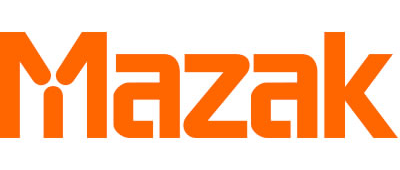
Mazak Corp. has unveiled its new INTEGREX i- 400AM (additive manufacturing) hybrid multitasking machine. As a fusion of additive technology and Mazak's most advanced multitasking capabilities, the machine will significantly reduce part cycle times while providing high-efficiency Done-In-One processing, according to the company.
As a turnkey system, the INTEGREX i-400AM offers manufacturers a new innovative alternative to conventional processing in terms of part design and machining. The technology is especially well-suited for small lot production of difficult-to-cut materials such as those used in the aerospace, energy and medical industries. With the additive capability, manufacturers can easily generate/clad near-net-shape component features then quickly complete them with high-precision finish machining operations, as well as laser mark parts if needed.
In operation, the INTEGREX i-400AM melts metal powder using fiber laser heat. Cladding heads (additive manufacturing nozzles) apply the molten material layer by layer, each of which solidifies as the desired shape grows. Plus, the system can join different types of metals to one another, a capability beneficial in the efficient repair of existing worn or damaged components, such as aerospace turbine blades.
Cladding heads store in the INTEGREX i-400AM's tool magazine, and the standard automatic toolchanger loads them into the machine's milling turret. Mazak offers two types of cladding heads: high speed or high accuracy. Users select the appropriate head based on the intended process and the particular metal powder to be used.
On the multitask machine side, the machine provides full 5-axis capability to easily process prismatic parts from solid billets or castings (chucked or bar fed), round parts, highly contoured parts and now those with features built using additive technology. The machine provides -30/+210 degree B-axis movement in its milling spindle, full C-axis contouring with its turning spindle and an NC tailstock that is fully programmable.
Contact Details
Related Glossary Terms
- automatic toolchanger
automatic toolchanger
Mechanism typically included in a machining center that, on the appropriate command, removes one cutting tool from the spindle nose and replaces it with another. The changer restores the used tool to the magazine and selects and withdraws the next desired tool from the storage magazine. The changer is controlled by a set of prerecorded/predetermined instructions associated with the part(s) to be produced.
- gang cutting ( milling)
gang cutting ( milling)
Machining with several cutters mounted on a single arbor, generally for simultaneous cutting.
- lapping compound( powder)
lapping compound( powder)
Light, abrasive material used for finishing a surface.
- milling
milling
Machining operation in which metal or other material is removed by applying power to a rotating cutter. In vertical milling, the cutting tool is mounted vertically on the spindle. In horizontal milling, the cutting tool is mounted horizontally, either directly on the spindle or on an arbor. Horizontal milling is further broken down into conventional milling, where the cutter rotates opposite the direction of feed, or “up” into the workpiece; and climb milling, where the cutter rotates in the direction of feed, or “down” into the workpiece. Milling operations include plane or surface milling, endmilling, facemilling, angle milling, form milling and profiling.
- numerical control ( NC)
numerical control ( NC)
Any controlled equipment that allows an operator to program its movement by entering a series of coded numbers and symbols. See CNC, computer numerical control; DNC, direct numerical control.
- toolchanger
toolchanger
Carriage or drum attached to a machining center that holds tools until needed; when a tool is needed, the toolchanger inserts the tool into the machine spindle. See automatic toolchanger.
- turning
turning
Workpiece is held in a chuck, mounted on a face plate or secured between centers and rotated while a cutting tool, normally a single-point tool, is fed into it along its periphery or across its end or face. Takes the form of straight turning (cutting along the periphery of the workpiece); taper turning (creating a taper); step turning (turning different-size diameters on the same work); chamfering (beveling an edge or shoulder); facing (cutting on an end); turning threads (usually external but can be internal); roughing (high-volume metal removal); and finishing (final light cuts). Performed on lathes, turning centers, chucking machines, automatic screw machines and similar machines.







